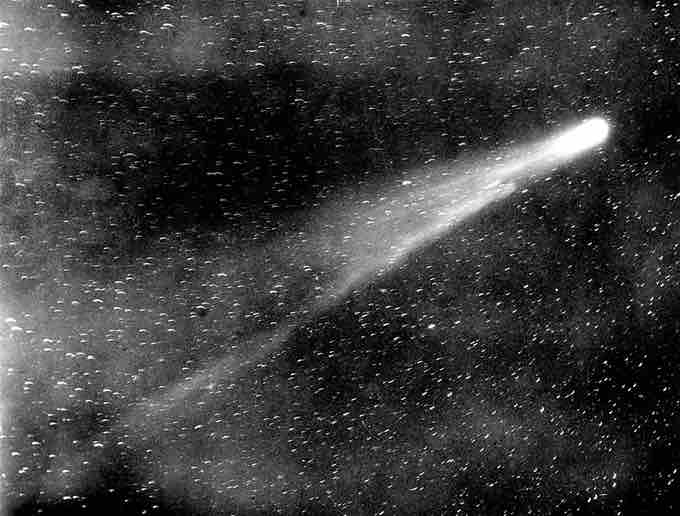Radiation pressure is the pressure exerted upon any surface exposed to electromagnetic (EM) radiation. EM radiation (or photon, which is a quantum of light) carries momentum; this momentum is transferred to an object when the radiation is absorbed or reflected. Perhaps one of the most well know examples of the radiation pressure would be comet tails. Haley's comet is shown in .

Halley's Comet
As a comet approaches the inner Solar System, solar radiation causes the volatile materials within the comet to vaporize and stream out of the nucleus. The streams of dust and gas thus released form an atmosphere around the comet (called the coma), and the force exerted on the coma by the Sun's radiation pressure and solar wind cause the formation of an enormous tail that points away from the Sun.
Although radiation pressure can be understood using classical electrodynamics, here we will examine the quantum mechanical argument. From the perspective of quantum theory, light is made of photons: particles with zero mass but which carry energy and – importantly in this argument – momentum. According to special relativity, because photons are devoid of mass, their energy (E) and momentum (p) are related by E=pc.
Now consider a beam of light perpendicularly incident on a surface, and let us assume the beam of light is totally absorbed. The momentum the photons carry is a conserved quantity (i.e., it cannot be destroyed) so it must be transferred to the surface; thus the absorption of the light beam causes the surface to gain momentum. Newton's Second Law tells us that force equals rate of change of momentum; thus during each second, the surface experiences a force (or pressure, as pressure is force per unit area) due to the momentum the photons transfer to it.
This gives us: pressure = momentum transferred per second per unit area = energy deposited per second per unit area / c = I/c, (where I is the intensity of the beam of light).
Laser Cooling
There are many variations of laser cooling, but they all use radiation pressure to remove energy from atomic gases (and therefore cool the sample). In laser cooling (sometimes called Doppler cooling), the frequency of light is tuned slightly below an electronic transition in the atom. Because light is detuned to the "red" (i.e., at lower frequency) of the transition, the atoms will absorb more photons if they move towards the light source, due to the Doppler effect. Thus if one applies light from two opposite directions, the atoms will always scatter more photons from the laser beam pointing opposite to their direction of motion (typical setups applies three opposing pairs of laser beams as in ).

The Magneto Optical Trap
Experimental setup of Magneto Optical Trap (MOT), which uses radiation pressure to cool atomic species. Atoms are slowed down by absorbing (and emitting) photons.
In each scattering event, the atom loses a momentum equal to the momentum of the photon. If the atom (which is now in the excited state) then emits a photon spontaneously, it will be kicked by the same amount of momentum, only in a random direction. Since the initial momentum loss was opposite to the direction of motion (while the subsequent momentum gain was in a random direction), the overall result of the absorption and emission process is to reduce the speed of the atom. If the absorption and emission are repeated many times, the average speed (and therefore the kinetic energy) of the atom will be reduced. Since the temperature of a group of atoms is a measure of the average random internal kinetic energy, this is equivalent to cooling the atoms. Simple laser cooling setups can produce a cold sample of atomic gases at around 1mK (=10-3 K) starting from a room temperature gas.